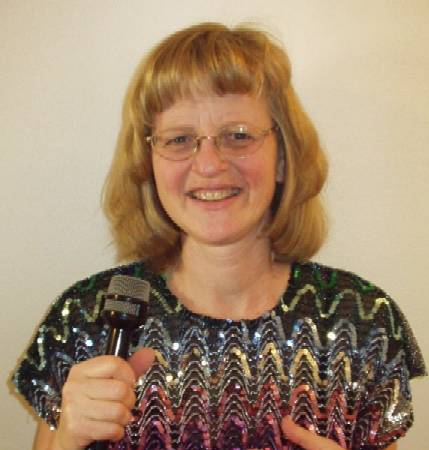 Biography
Biography Biography
BiographyMerri Rudd is a well-known dancer and caller in the Southwest. Her repertoire includes all kinds of contras, English country, and a few fun squares, as requested.
"We had so much fun working with you and experiencing your wide range of styles, your amazing ability to make people not only comfortable but ready to also try something new, and your fun sense of humor. We saw behind the scenes how much preparation and thought you had given to the weekend, but you have the great ability to make it all seem spontaneous -- a recipe for success for dancers, musicians, caller, and camp. We hope we have the opportunity to work with you somewhere again soon!!!!"
Sande Gillette, Anita Anderson, and Dave Bartley
Bag o' Tricks, Seattle, WA, re: Wasatch Wiggle gig, July 2006
Here's what several dancers have to say about Merri:
"Quirky-Albuquerquean caller, Merri Rudd, reigns in New Mexico with abundant wit and charm. Her dances are often replete with literary quotes, funny quips, and lots of fast swings, gypsy's, and medleys!"
"I just like your manner on the stage more than any other caller, regardless of experience or reputation. You are cheerful, funny, upbeat, intelligent without being stuffy; a delicate yet solid balance of poise, confidence and humility." Rick Piel, former Austin, TX dance organizer, now living in Portland, OR
"I just wanted to say thank you for all your joy and delight in the dance. Your energy radiates from the stage and permeates the dance." Seth Tepfer, Atlanta, GA
"Merri Rudd is one of the most fun and competent contra callers around. She has a bright and cheerful style, and is articulate, intelligent, and witty."
"Merri Rudd's enthusiasm for contra dance is evident and infectious. Her clear teaching style and calm demeanor assure the novice, while the depth of her knowledge and her interesting repertoire of dances delight the experienced."
Merri's gentle, relaxed style puts everyone at ease. Her contagiously energetic and enthusiastic manner of calling and high-energy dances leave you connected to the music, begging for more.
[What follows are the last 500 words of a 7,000 word essay I wrote about singing a square onstage for the first time ever. I hope it satisfactorily summarizes why I enjoy calling dances. A modified version of the following essay appeared in the Country Dance and Song Society News, Issue 196, May/June 2007, page 15.]
After I started contra dancing in 1981, I sat on the periphery of music, sometimes at a dance, sometimes a concert, sometimes around a fire in the middle of a field, or in a cabin amid piles of snow. I listened to others proliferate wonderful, rowdy, driving music and was unable to participate. I wished fervently to speak the language of music, but I never found the notes, never had any musical ability, never had a role.
Learning to call dances gave me a role. For years I admired musicians and callers and the bridges they created for the dancers. And so I learned to be a bridge. I bridge the music and the dance. I connect the players and dancers. And when it all comes together in a synergistic way, indeed, magic happens.
Getting on stage that first time in April 1991 was the greatest leap of faith I ever made. It took me more than a year to get there, fifteen months after I first attended a calling workshop with Bill "Doc" Litchman one weekend in January 1990. I could not bring myself to get on stage in front of people and interact with dancers and musicians, all alone. I practiced and struggled, and finally I stood on stage, out of excuses.
Even my non-dancing hubby Mark showed up for my debut. I gripped the microphone, I cued the band, and I called Don Armstrong's "Broken Sixpence." Flawlessly. The dancers and musicians erupted into shouting so loud, so sustained, and so spirited that I tried calling one dance again, a few months later. On December 7, 1991, at the Lloyd Shaw Dance Center with Megaband backing me up, I called my first whole evening of dances. I only knew ten dances, and I called them all.
That first year or two of calling my knuckles stretched white and my hands ached from holding the microphone so tightly. I counted the beats of the music in my head to time my calls correctly, "1, 2, 3, 4, LA-dies CHAIN a-CROSS now...." Several years into it, I realized I knew where I was in the music, which was the second A part or the first B part, or when a tune was irregular. I became not only a dance teacher and leader, but also a band director, choosing dances to complement tunes, setting tempos, cuing the band to switch tunes, speed up, slow down, and finally stop. All of this looks easy when you gain experience. But, believe me, it's not as easy as it looks.
Once a musician told me, "You are one of the few who thinks the musicians are important. You appreciate us."
"Important?!" I exclaimed, "It is because of you that dance is possible."
And so I became a bridge to what is possible, not a big, commercial, concrete and steel giant spanning a metropolis, but a small, wooden bridge over a babbling, musical creek. Maybe Pan plays his lute on the shore or a Civil War fiddler and banjo player tune up, leaning against an old gnarled tree. And maybe the women are there in gauzy gowns, with flowers in their hair, and the men are bowing to their favorite partner. But there I am, too, figuring out how it all fits together. Why? Because. Because I finally have a role.
(c) 2004, 2007, Merri Rudd, All Rights Reserved
Please contact Merri Rudd.
revised 9/12/07
Copyright © 2006 by Merri Rudd